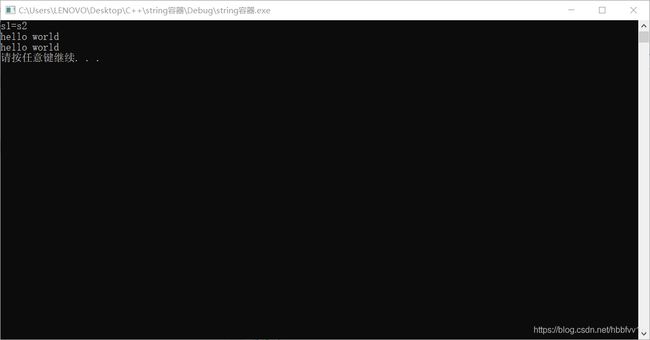C++string容器详解
文章目录
-
- 1.概述:
- 2.string的构造函数
- 3.string的赋值操作
- 4.string的拼接操作
- 5.string的子串获取操作
- 6.string的插入与删除
- 7.string的替换与查找字符操作
- 8.string的字符串比较操作与尾插操作
- 9.string字符存取操作
1.概述:
string是C++风格的字符串,而string本质上是一个类
string是STL的字符串类型,通常用来表示字符串。而在使用string之前,字符串通常是用char*表示的。string与char*都可以用来表示字符串,不过二者之间也有差别
1.char*是一个指针
2.string是一个类,类内部封装了char*,管理这个字符串,是一个char*型的容器
2.string的构造函数
构造函数原型:
1.string(); //创建一个空的字符串 例如: string str;
2.string(const char* s); //使用字符串s初始化
3.string(const string& str); //使用一个string对象初始化另一个string对象
4.string(int n, char c); //使用n个字符c初始化
示例:
#include3.string的赋值操作
赋值的函数原型:
1.string& operator=(const char* s); //char*类型字符串 赋值给当前的字符串
2.string& operator=(const string &s); //把字符串s赋给当前的字符串
3.string& operator=(char c); //字符赋值给当前的字符串
4.string& assign(const char *s); //把字符串s赋给当前的字符串
5.string& assign(const char *s, int n); //把字符串s的前n个字符赋给当前的字符串
6.string& assign(const string &s); //把字符串s赋给当前字符串
7.string& assign(int n, char c); //用n个字符c赋给当前字符串
示例:
#include4.string的拼接操作
目的:实现在字符串末尾拼接字符串
函数原型:
1.string& operator+=(const char* str); //重载+=操作符
2.string& operator+=(const char c); //重载+=操作符
3.string& operator+=(const string& str); //重载+=操作符
4.string& append(const char *s); //把字符串s连接到当前字符串结尾
5.string& append(const char *s, int n); //把字符串s的前n个字符连接到当前字符串结尾
6.string& append(const string &s); //同operator+=(const string& str)
7.string& append(const string &s, int pos, int n);//字符串s中从pos开始的n个字符连接到字符串结尾
示例:
#include5.string的子串获取操作
s.substr(pos,n)
返回一个string,包含s中从pos开始的n个字符的拷贝,pos的默认值为0
示例:
#include6.string的插入与删除
插入:s.insert(pos,args)
在pos前插入args指定的字符
删除:s.erase(pos,len)
删除从位置pos开始的len个字符,如果省略len,则删除从pos开始直至s末尾的所有字符
示例:
#include7.string的替换与查找字符操作
查找:s.find(args)或s.rfind(args)
s.find为从左向右查找,查找第一次args出现的位置
s.rfind为从右向左查找,查找最后一次args出现的位置
注意:查找返回的是一个unsigned int类型,用int接收并不明智
替换:s.replace(range,args)
删除s中范围range内的字符,替换为args指定的字符
replace操作是调用erase和insert的简化形式
示例:
#include8.string的字符串比较操作与尾插操作
字符串比较:s.compare(s1) 尾插:s.append(args) 示例: string中单个字符存取方式有两种 1.char& operator[](int n); //通过[]方式取字符 示例:
s与s1相等返回0,s>s1返回大于0的值,s
将args追加到s,返回一个指向s的引用#include9.string字符存取操作
2.char& at(int n); //通过at方法获取字符#include





